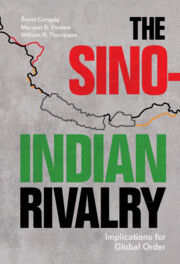Book contents
- The Sino-Indian Rivalry
- The Sino-Indian Rivalry
- Copyright page
- Contents
- Figures and Maps
- Tables
- Acknowledgments
- Part I Introduction
- Part II Spatial and Positional Considerations and Violence
- Part III The Evolution of the Rivalry
- Part IV Interconnected Rivalries and Systemic Considerations
- Chapter 7 The Emergence of a Triadic Rivalry
- Chapter 8 The Sino-Indian Rivalry in Regional and Global Context
- Part V Conclusion
- Bibliography
- Index
Chapter 8 - The Sino-Indian Rivalry in Regional and Global Context
from Part IV - Interconnected Rivalries and Systemic Considerations
Published online by Cambridge University Press: 15 June 2023
- The Sino-Indian Rivalry
- The Sino-Indian Rivalry
- Copyright page
- Contents
- Figures and Maps
- Tables
- Acknowledgments
- Part I Introduction
- Part II Spatial and Positional Considerations and Violence
- Part III The Evolution of the Rivalry
- Part IV Interconnected Rivalries and Systemic Considerations
- Chapter 7 The Emergence of a Triadic Rivalry
- Chapter 8 The Sino-Indian Rivalry in Regional and Global Context
- Part V Conclusion
- Bibliography
- Index
Summary
The way in which major power wars have escalated into general or systemic wars is less straightforward than one might think. They start for various reasons and then become something else when other major powers join the fray and turn them into systemic wars. The initial grievances in these systemic wars may seem like acorns that become mighty trees. How, for example, does a bungled assassination of an Austrian archduke or even an attack on Poland mushroom into war on multiple continents? One answer is in the ways rivalries are linked. While it is true that the specifics of each systemic war have unique components, there are also some general features as well. One is that decision-makers do not tend to see general wars coming. They make decisions based on short-term considerations without necessarily seeing the big picture. That bigger picture includes linked or fused rivalries that blow up relatively local concerns into global wars. This chapter uses the Seven Years and Crimean Wars as examples. Rivalries like the Sino-Indian rivalry can be conduits to widening the local concerns that have the capability to become transformed into something far greater and more damaging.
- Type
- Chapter
- Information
- The Sino-Indian RivalryImplications for Global Order, pp. 176 - 198Publisher: Cambridge University PressPrint publication year: 2023



